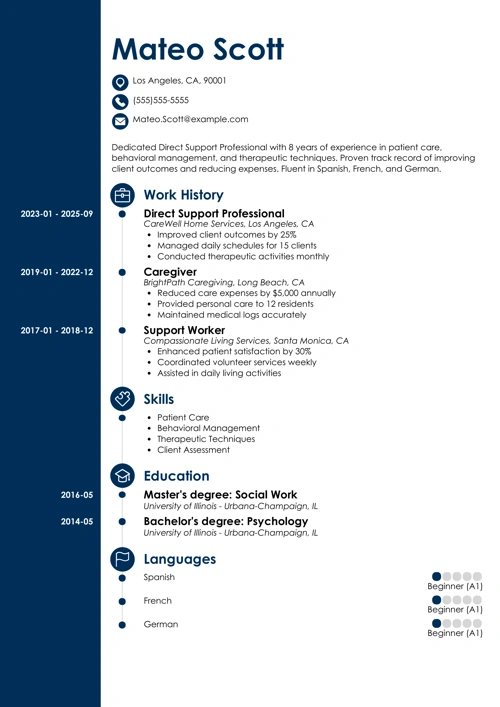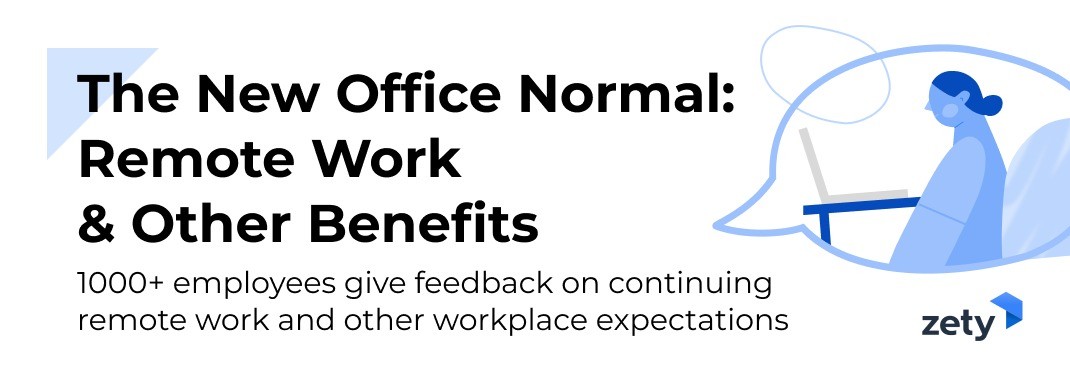
Home office sweet home office.
Many of us, just before our work begins, wake up with this jolly thought in our minds. There is no need to take a dog for a walk at daybreak, iron your clothes, rush to catch the bus, or sit in traffic.
If the COVID-19 pandemic had a positive, it has to be the growth of working from home.
Some love it, remote work advocates have raised their voices loudly in support. But some hate it. Neighbors doing renovations, crying babies, feelings of loneliness, FOMO, and more. The benefits are obvious, but the frustrations are real too.
Regardless of which camp you’re in, it can’t be denied that the world of work has changed irreversibly.
- According to the U.S. Census Bureau, from 2019 to 2021, the number of people working from home tripled from 5.7% to 17.9%.
- Remote work is seen as a huge success by employers and employees alike. A 2021 PwC survey revealed that 83% of employers say remote work has been a positive move for their company
- According to Buffer’s State of Remote Work Survey, 98%of remote workers want to continue home office at least some of the time. Hybrid work is here for good.
- Workers are ready to make sacrifices to stay remote. Owl Labs found that 46% would take a pay cut of up to 5% to work at least part of the time remotely.
- Despite the above, around 44% of companies worldwide don’t allow remote work.
But remote work isn’t just about health issues anymore. Now, it’s about money, time, and flexibility.
Add to these rising salary expectations, inflation, dissatisfaction, and the quiet quitting trend, and you get an explosive mix. All indications are that the remote vs. office war is heating up, and now more than ever, we need a data-driven view of the battlefield.
Zety took up the challenge and surveyed 1000+ US workers to predict the future of the new office reality. This allowed us to answer the following questions:
- What do employees want from work?
- Will employees really quit when forbidden to work remotely?
- Will the desire to lure workers to the offices turn out to be just a fantasy?
- What benefits do staff really value?
- Are fancy office perks all they’re cracked up to be?
Keep scrolling to find out.
US working status
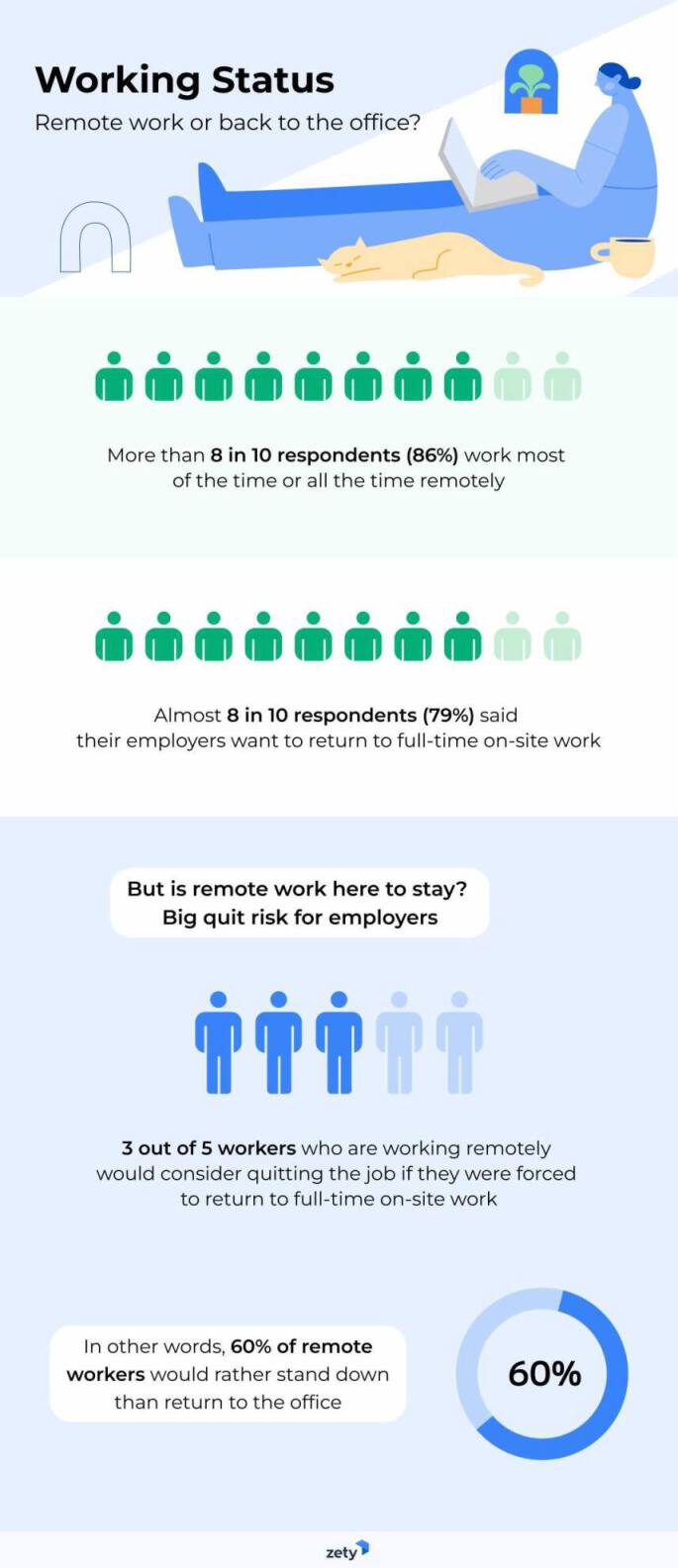
First, we asked the biggest question of all. What is your working status? And as you can see from the infographic above, 86% ofour respondents work mostly or entirely remotely.
The number is enormous, yet not surprising. Since the beginning of the global pandemic, employees have had a crush on the home office. So, even now, nearly three years after the pandemic outbreak, they’re still working entirely or some of the time remotely.
But the fate of 79% of US employees may change soon, as their employers plan to re-introduce full-time on-site work. The execution of the “come-back-to-office” judgment has just been postponed.
“The string of events has officially turned return-to-office plans into The Great Wait.”
That’s how Kate Bullinger, CEO of the management consultancy United Minds
Is winter coming? It is, literally and figuratively. Many companies have announced their return-to-office plans. Goldman Sachs, Tesla, Apple, Peloton, and many more are pushing employees to on-site work at least three days a week.
The duel of giants is here: office vs. home, companies vs. employees. But still, a particular question needs to be asked: who will win this fight?
Let’s now take a closer look at our opponents. In the one corner of the ring, we have employers. In the opposite corner, there are employees. Dissatisfaction hangs in the air. Remote work is at stake.
Let’s get ready to rumble!
Ladies and Gentlemen, an unexpected twist happened. Workers bring out the heavy guns.
They hit employers with a killer combo.
They threaten to quit!
People want to continue working remotely, at least in a hybrid model. And other studies back this too.
Pew Research Center asked people whether they would like to work from home all or most of the time if given a choice. 60% said they’d like to maintain remote work.
The reasons for that are simple. And it’s not just convenience, reluctance to listen to Amy gossiping on the phone again, or smelling Jack’s fish for lunch.
Let’s look at more facts about teleworking:
- It’s achievable. Global Workplace Analytics (GWA) estimates that about 75 million U.S. employees—56% of the workforce—have jobs where at least some duties could be done remotely.
- It saves money. GWA believes that employees could save between $600 and $6,000 a year by working at home just half the time. The savings are possible due to reduced travel, parking, and food costs. The other side also benefits. The International Work Group reports that organizations may save an average of $11,000 yearly for every employee working remotely for half of the week. Here, the savings come from reduced property costs or lower employee absences.
- It saves time. Again, the same organization estimated that an employee working remotely half-time saves the equivalent of 11 workdays per year. It’s time that they would have otherwise spent commuting.
- It helps the environment. As GWA emphasizes, if those who can work remotely continue to do so at least part of the time, it would save 54 million tons of greenhouse gas emissions. This equals taking almost 10 million cars off the road for a year. For homework, find out how many vehicles travel on the streets of New York City.
What’s the most convincing reason?
Money. Both for employees and employers. For many workers, the return to the office is now wrapped up in an expense of travelling, child care, coffee and lunch, or even new clothes.
According to the dollar signs, remote work is here to stay. And employees have a lot more leverage to get what they want. But employers see the situation differently.
The question is – how on earth can companies convince employees that their daily presence in the office is necessary? They can’t. And those who know that their presence in the office is essential are already working on-site. But there are other methods.
And if you’re searching for inspiration, look at Envoy, a workplace platform. As Annette Reavis, Envoy’s chief people officer, says, the company “is trying to remove some of the financial burden but also build community.” So they started to offer their employees a shuttle service, a carpool program, and a $200 monthly subsidy to cover travel expenses. And once the employees arrive at the office, free bagels, snacks, and fruit await them. Moreover, dog owners are encouraged to bring their pets to work, so they don’t have to pay for pet care.
Not just remote work
Employee benefits have evolved enormously over the past years and are knocking on our door. From mediocre sports packages or education assistance, we moved to work-life balance, mental health, loose schedules, or a four-day work week. During the pandemic and economic changes, our value system changed significantly. People revised their needs and took a second look at what they expected from work.
And as additional benefits are part of work reality, and can help tip the balance in favor of the office, we also covered that in our study.
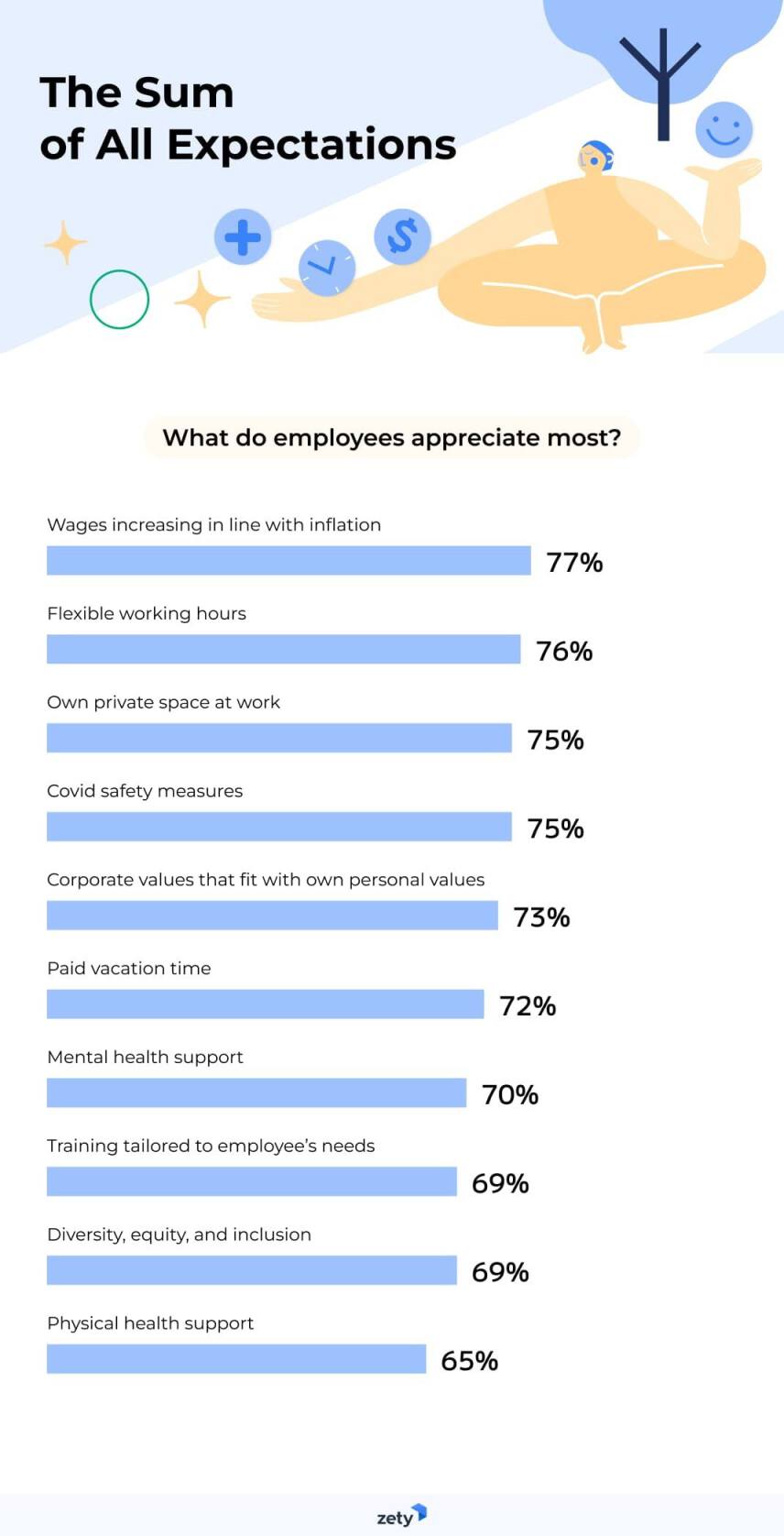
By simply asking, “What’s important in the workplace?” (apart from remote work, of course), we discovered these top factors:
- First, wages increasing in line with inflation – 77%. Not surprising at all, as US consumer prices rose around 8.3% in the last 12 months.
- The runner-up, flexible working hours – 76%. Workers in 2022 want to fit work around other commitments.
- Own private space at work – 75%. A consolation prize for the loss of a home office.
- Covid safety measures – 75%. Still important.
- Now it’s time for something we can identify with. These are corporate values that fit with own personal values – 73%.
- Paid vacation time – 72%. Will it be a standard one day and not a benefit?
- Mental health support – 70%. Particularly important in the face of rising rates of job burnout.
- Individual development matters, as our list proves, training tailored to employees’ needs – 69%.
- Diversity, equity, and inclusion – 69% – definitely something people value in a healthy workplace.
- Last, but still important, physical health support – 65%.
We cannot deny that workplace ’22 is about money. But we already know that economic factors are proving to be more crucial than ever.
So how to make this depressing reality less sad?
Fancy perks for all!
We’ve just taken a look at benefits that might be classified as “standard.” Employers offered them even before the pandemic, and they’re not exactly jaw-droppers.
But there are a bunch of benefits that most of us can dream of. Some spark our envy, such as concierge services. Others, like egg freezing, are contentious.
Here, we focused on more down-to-earth fancy perks like premium office design, ping pong tables, massages, or free catered lunches.
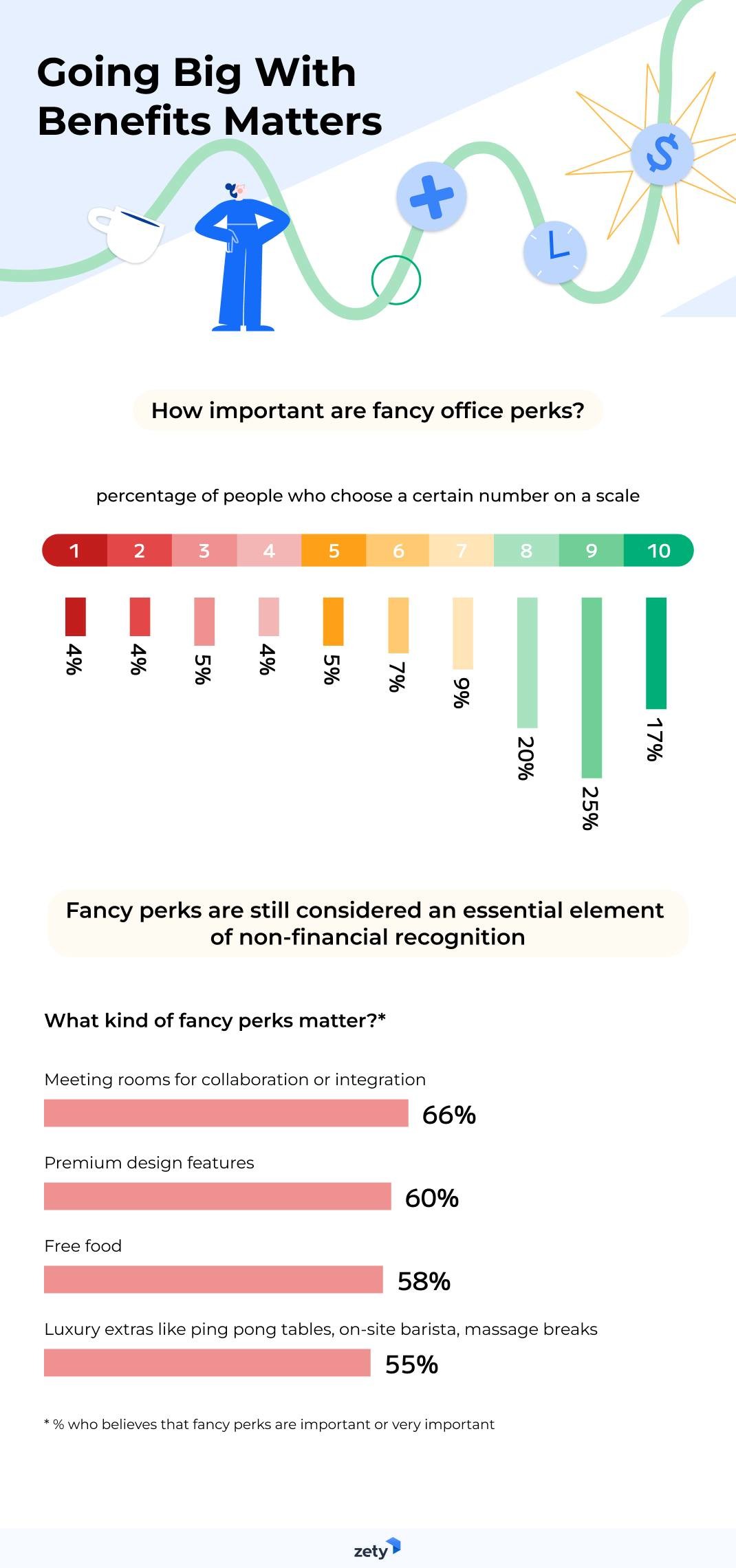
Our respondents again met the challenge and ranked fancy perks as a big consideration in the modern workplace. Employers looking to get those seats warm again take note.
For the infographic above we used an importance scale, where 1 means not important at all, while 10 stands for highly important. To verify how many respondents believe that fancy perks are meaningful, we counted the votes of those who rated their importance at 7 or more. By this measure, a total of 71% of respondents rate fancy perks as important or highly important.
So what is valued?
- Meetings room for collaboration or integration – 66%. Not surprising, as the pandemic has reinforced our need for social interaction.
- Premium design features – 60%. After all, everyone wants a bit of luxury.
- Free food – 58%. Let’s be honest, anything free tastes better.
- Other stuff like ping pong tables, an on-site barista, and massage breaks – 55%. Relaxation can be something we come to work for.
These definitely go beyond what an average company usually offers. But jokes aside. Businesses attempting to attract and retain talents are coming up with even more innovative perks. This process is supported by the growing demands of employees and their imagination.
Clearly, a mere monthly payment isn’t enough to meet the expectations of most employees. But even when putting aside fancy office perks, most professionals still favor employers with a great culture, robust set of values, and benefits in line with their needs.
Just see for yourself.
Values that matter
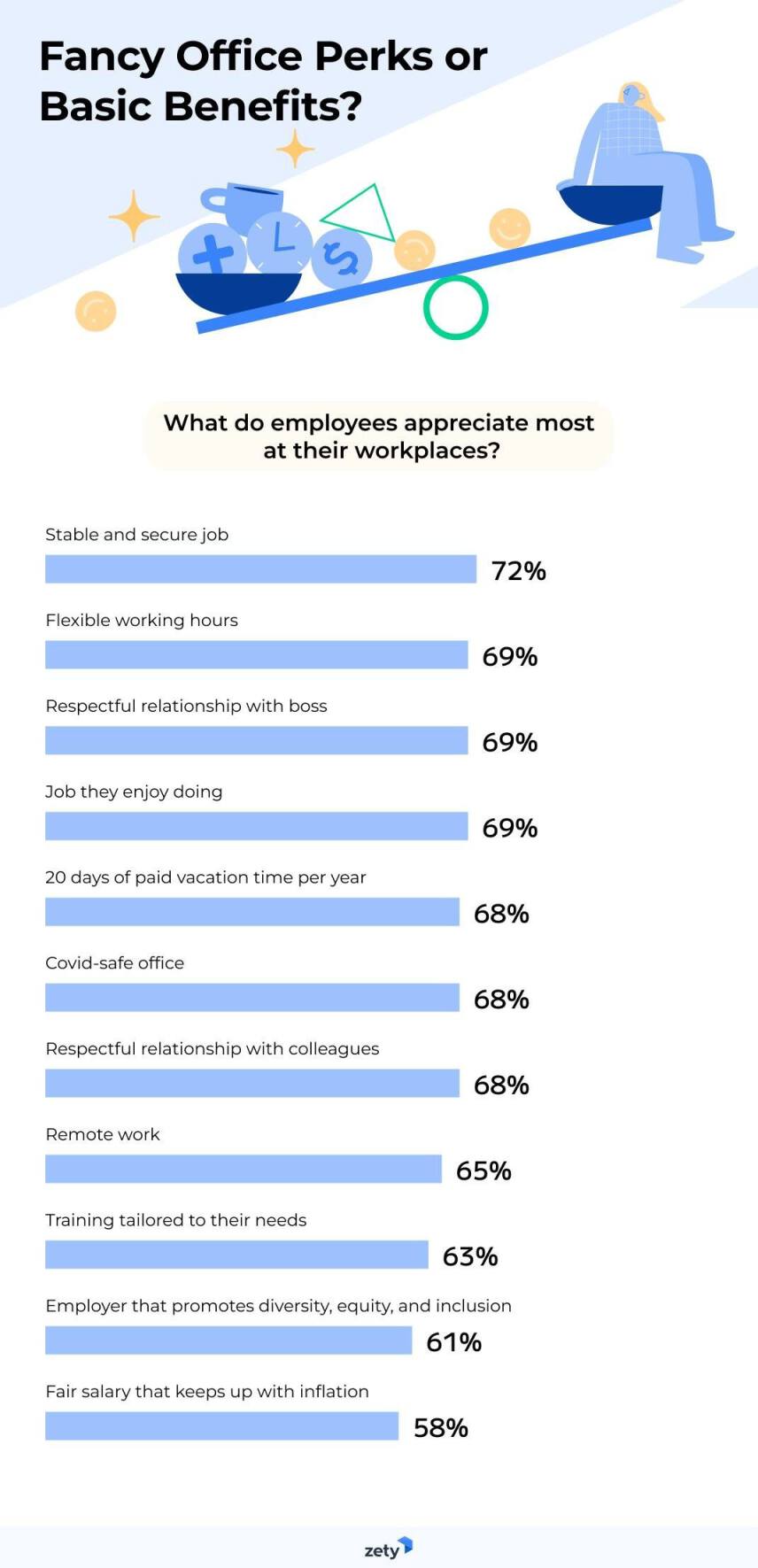
We’ve established that many employees value fancy office perks at their workplace. But we decided to go further and force respondents to make a tough choice. We presented our respondents with a series of scenarios and asked them to choose whether they’d prefer fancy office perks or standard alternatives that sometimes aren't even benefits.
The result is: the majority of the US workforce (58–72% depending on the alternative) would give up fancy perks in favor of more down-to-earth options.
In no scenario did fancy perks win. People really value:
- Stable and secure job – 72%
- Flexible working hours – 69%
- Respectful relationship with boss – 69%
- Job they enjoy doing – 69%
- 20 days of paid vacation time per year – 68%
- Covid-safe office – 68%
- Respectful relationship with colleagues – 68%
- Remote work – 65%
- Training tailored to their needs – 63%
- Employer that promotes diversity, equity, and inclusion – 61%
- Fair salary that keeps up with inflation – 58%
A stable and secure job (72%) somewhat predictably topped the list. It ranked as more significant than any other alternative given. In fact, it proved more valuable than a salary that keeps up with inflation. The pandemic and economic instability have probably dipped their toe into this, prompting us to place a higher value on job security.
But is it all about benefits?
But we are all different and have different workplace needs and expectations. To discover the complete picture, we asked respondents to complete a list of things that matter in the workplace.
Guided by their experience, they pointed out several areas that weren’t covered in our survey. Their comments helped us to bridge the gap.
So what else is significant? Here’s what they told us:
“Safety from being bullied and harassed.”
“It’s fine to have people in charge as long as all voices are heard.”
“Having leadership that takes an interest in employees.”
“Feel valued and be a core part of the team.”
“Being given feedback, whether good or bad.”
“Career advancement.”
“No micromanaging.”
“Strong work ethic.”
“Non-toxic environment”.
“Opportunity to grow.”
Surprisingly, answers were not dominated by salary-related issues. Of course, money-related problems also appeared, but the aspects mentioned above resonated much more strongly. This may make us think that money alone is “overrated.” We assume that a satisfying salary is the main basis for working in a given company. But our findings show that there are plenty of other vital factors too.
Safety from being bullied and harassed, being heard by people in charge, a strong work ethic, or a non-toxic environment are just a few examples of what employees value in the workplace.
“I’m not sure that work is any more dysfunctional now for many workers than it’s been in the past. The experiences of the pandemic have brought these conversations of dysfunction to the fore. More workers are speaking up and speaking out about the quality of their jobs in a way they haven’t before.”
Getting to the point
Without a doubt, every employee has different needs. While some love remote work, others prefer a shiny new designer office offering an on-site gym and ping-pong tables.
That’s why companies must understand what workers want from the workplace. Their expectations should be the starting point for developing any benefit programs.
Diversity is key.
Finally, here’s a quick rundown of the study’s key findings:
- As much as 60% of employees are willing to quit if forced to return to full-time on-site work.
- At the same time, 79% of companies plan to re-introduce full-time on-site work.
- All the research and data prove that home office is here to stay despite some employers’ desires to introduce full-time on-site work. So a hybrid model may be the best remedy.
- The US workforce is willing to skip fancy office perks in favor of a stable and secure job, flexible working hours, or respectful relations with the boss.
And the top four factors that US employees will most likely appreciate at work are:
- Wages increasing in line with inflation (77%)
- Flexible working hours (76%)
- Own private space at work
- Covid safety measures (75% each).
Methodology
The findings presented were obtained by surveying 999 American respondents. They were asked questions about their views on the ideal workplace in 2022/2023. These included yes/no questions, scale-based questions relating to levels of agreement with a statement, questions that permitted the selection of multiple options from a list of potential answers, and a question that permitted open responses. All respondents included in the study passed an attention-check question.
Limitations
The data we are presenting relies on self-reports from respondents. Each person who took our survey read and responded to each question without any research administration or interference. We acknowledge there are many potential issues with self-reported data like selective memory, telescoping, attribution, or exaggeration.
Sources
- Buffer, “State of Remote Work 2021”
- Federal Reserve Bank of St. Louis, “Multiple Jobholders, Primary and Secondary Jobs Both Full Time”
- Global Workplace Analytics, “How many people could work from home”
- Laurinas, M., “How American Workers are Combating Inflation”
- Liu, J., “For many workers, the return to offices has become ‘The Great Wait.’ It’s costing employers millions”
- Liu, J., “Why does work feel so dysfunctional right now? A psychologist, labor expert and CEO weigh in”
- Lufkin, B., “Is finding a ‘new normal’ in the workplace impossible?”
- Mosley, E., “Offices in 2022: Here’s What the ‘New Normal’ May Look Like”
- Owl Labs, “State of Remote Work 2021”
- Parker, K., Horowitz J.M., Minkin, R., “COVID-19 Pandemic Continues To Reshape Work in America”
- PWC, “PwC’s US Remote Work Survey”
- Rogers, T., “Expensive commutes and $14 lunches: how inflation hampers back-to-work push”
- United States Census Bureau, “The Number of People Primarily Working From Home Tripled Between 2019 and 2021”
- Waldman, S., “Telecommuting Could Outlive the Pandemic, Lowering Emissions”
- Wong, P.T., “Hybrid working can save employers US$11,000 per worker a year: IWG”
- Woolf, M., “Is Remote Work Here to Stay? [2021 Study]”
Fair Use Statement
Feeling inspired by this article? Feel free to share our findings! All we ask is that you link back to this page and give full credit to our authors.
About Zety’s Editorial Process
This article has been reviewed by our editorial team to make sure it follows Zety's editorial guidelines. We’re committed to sharing our expertise and giving you trustworthy career advice tailored to your needs. High-quality content is what brings over 40 million readers to our site every year. But we don't stop there. Our team conducts original research to understand the job market better, and we pride ourselves on being quoted by top universities and prime media outlets from around the world.
